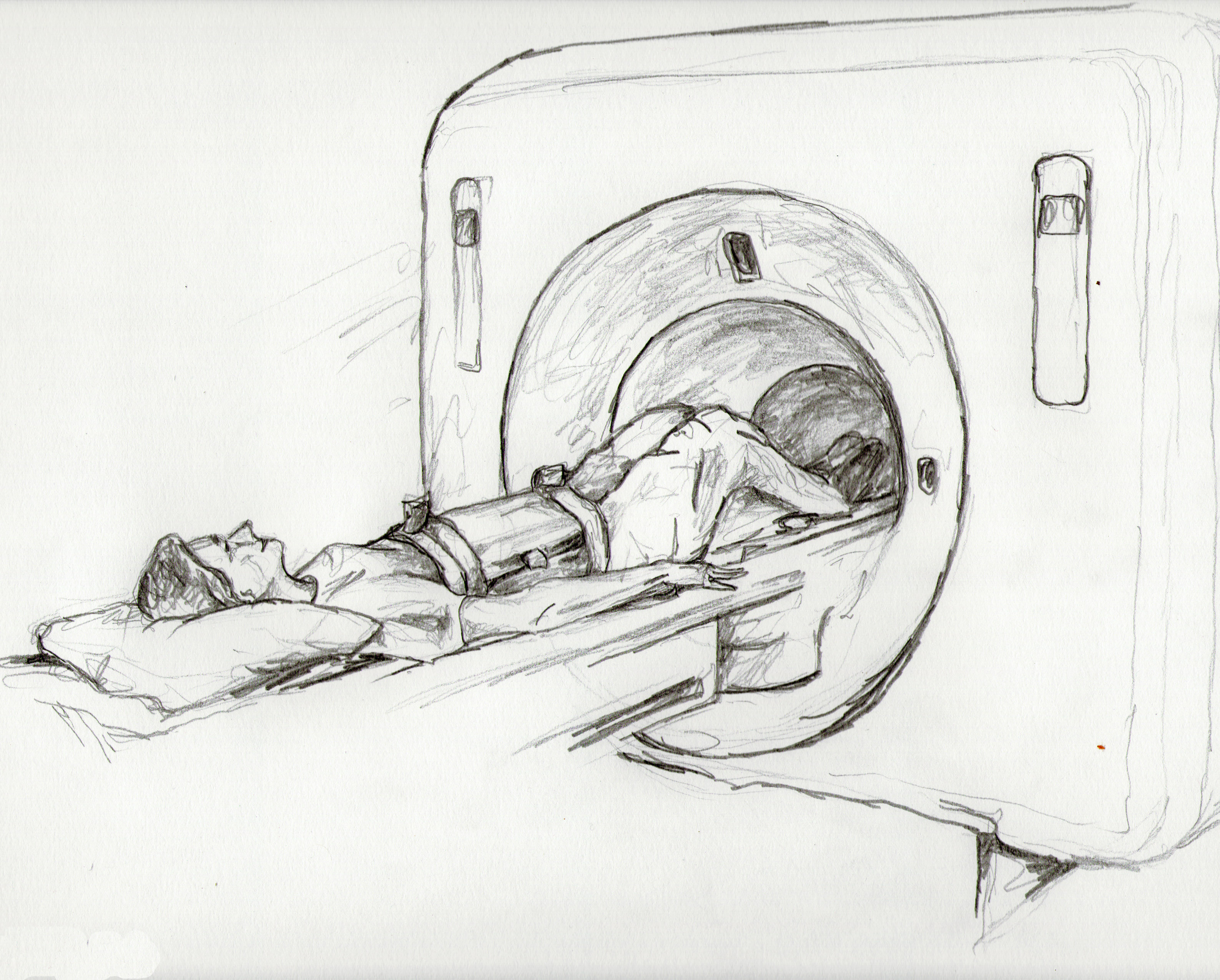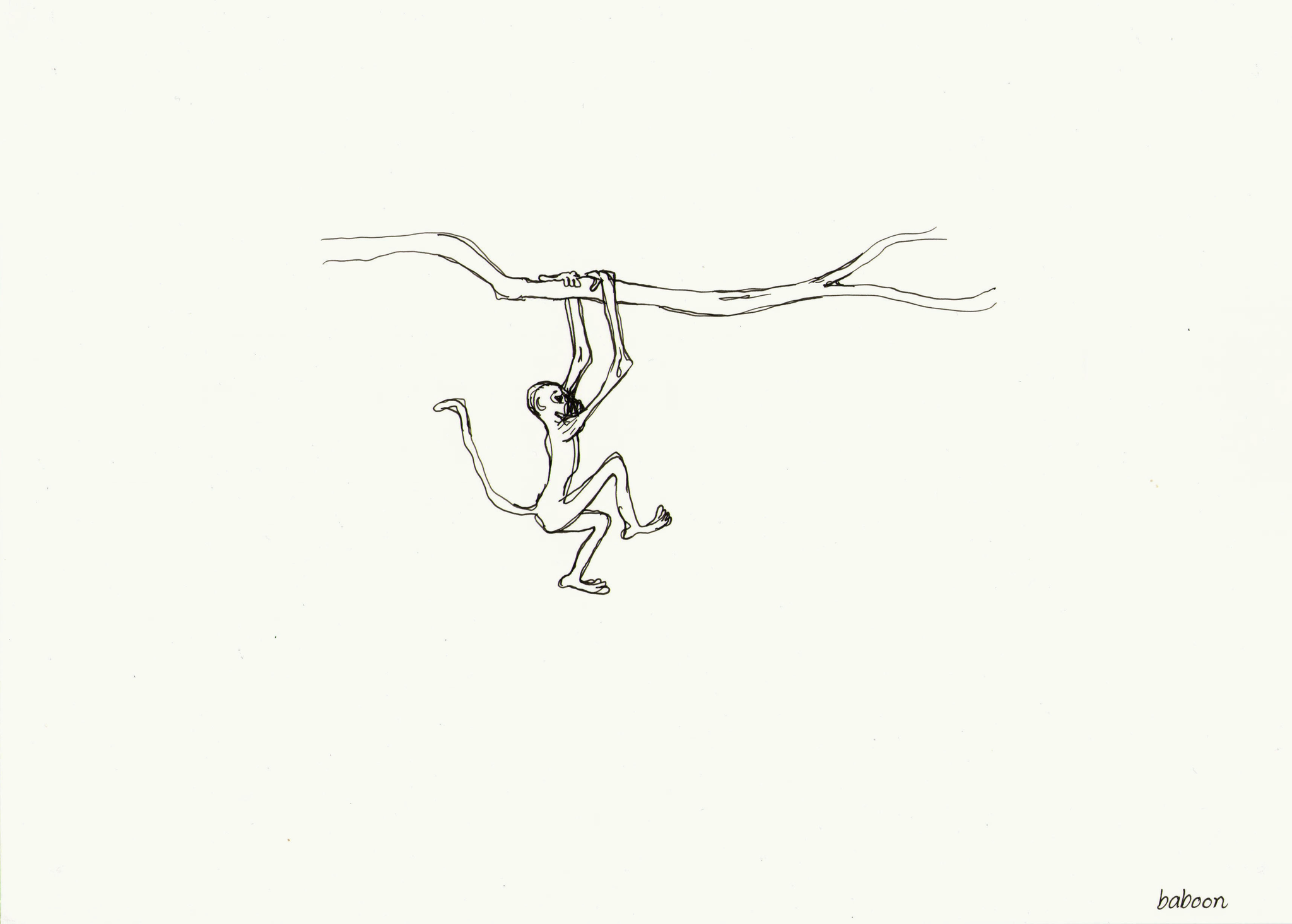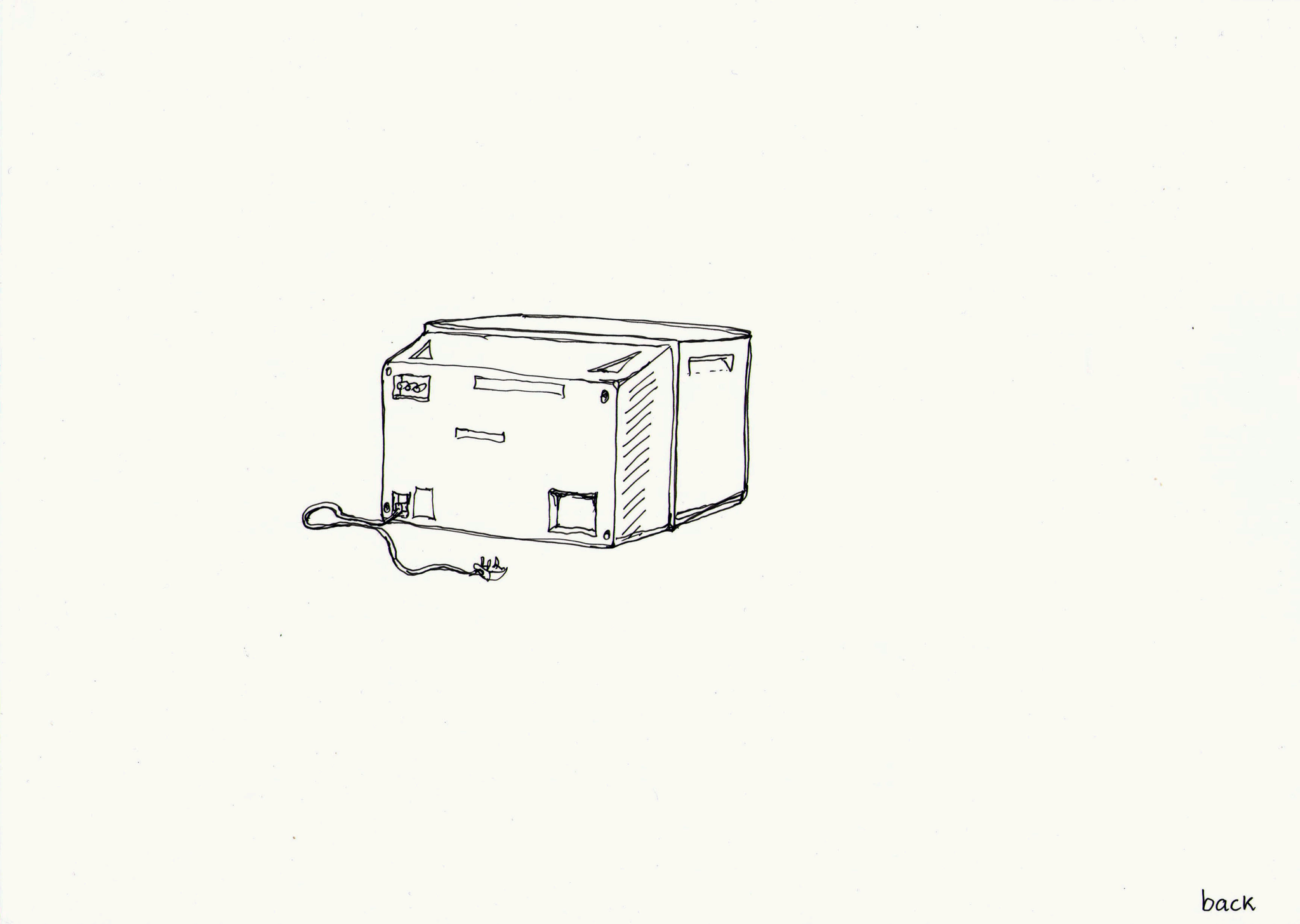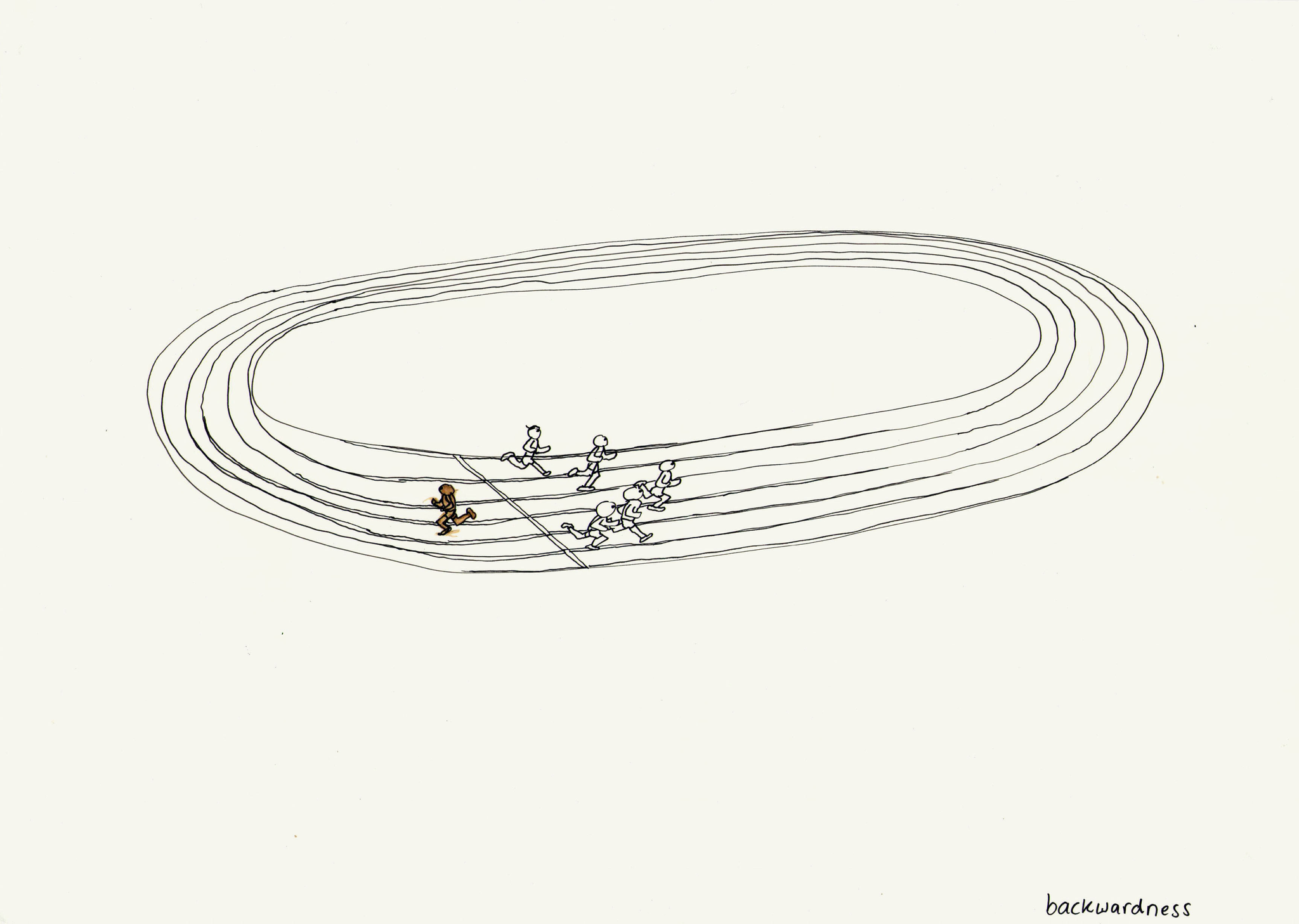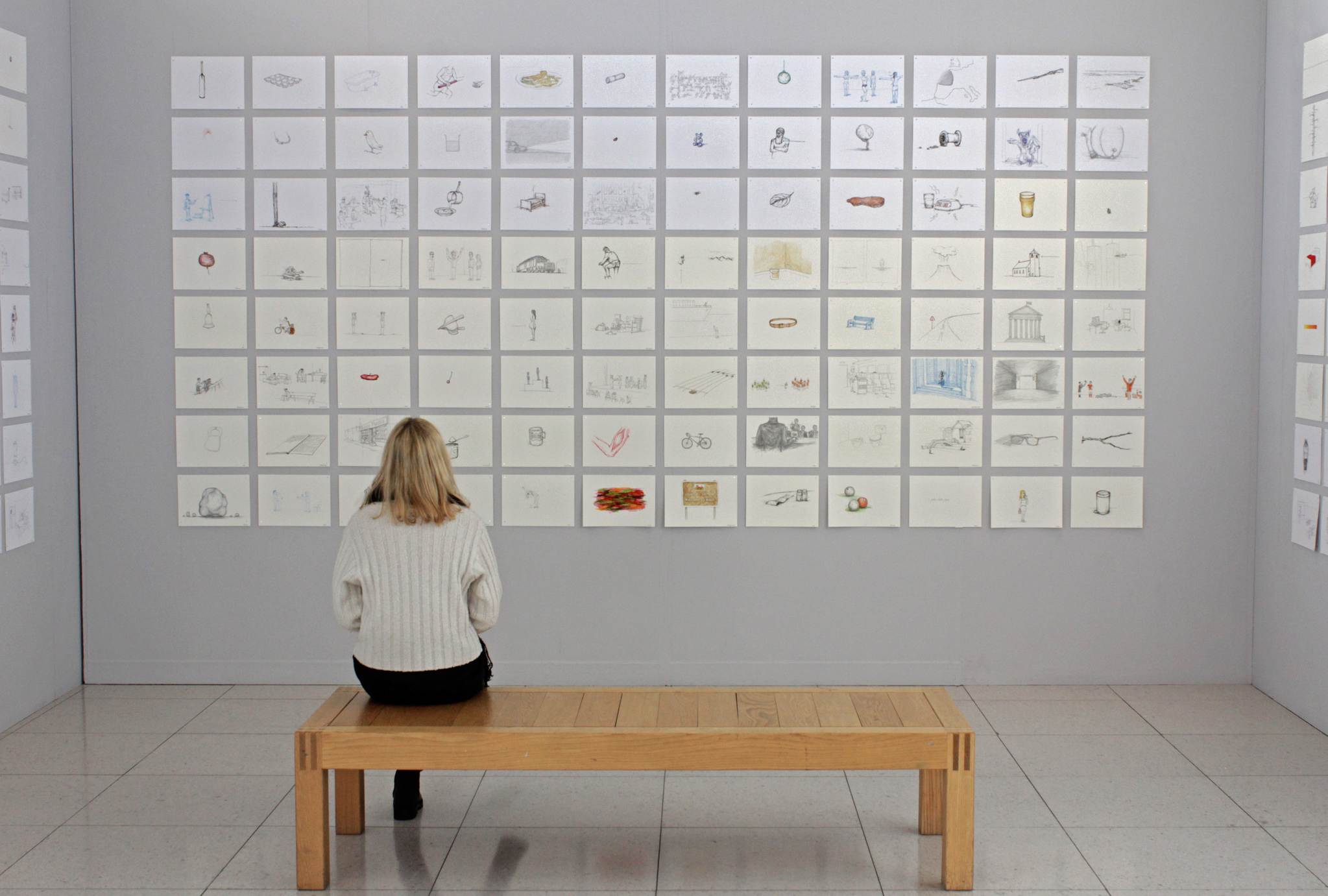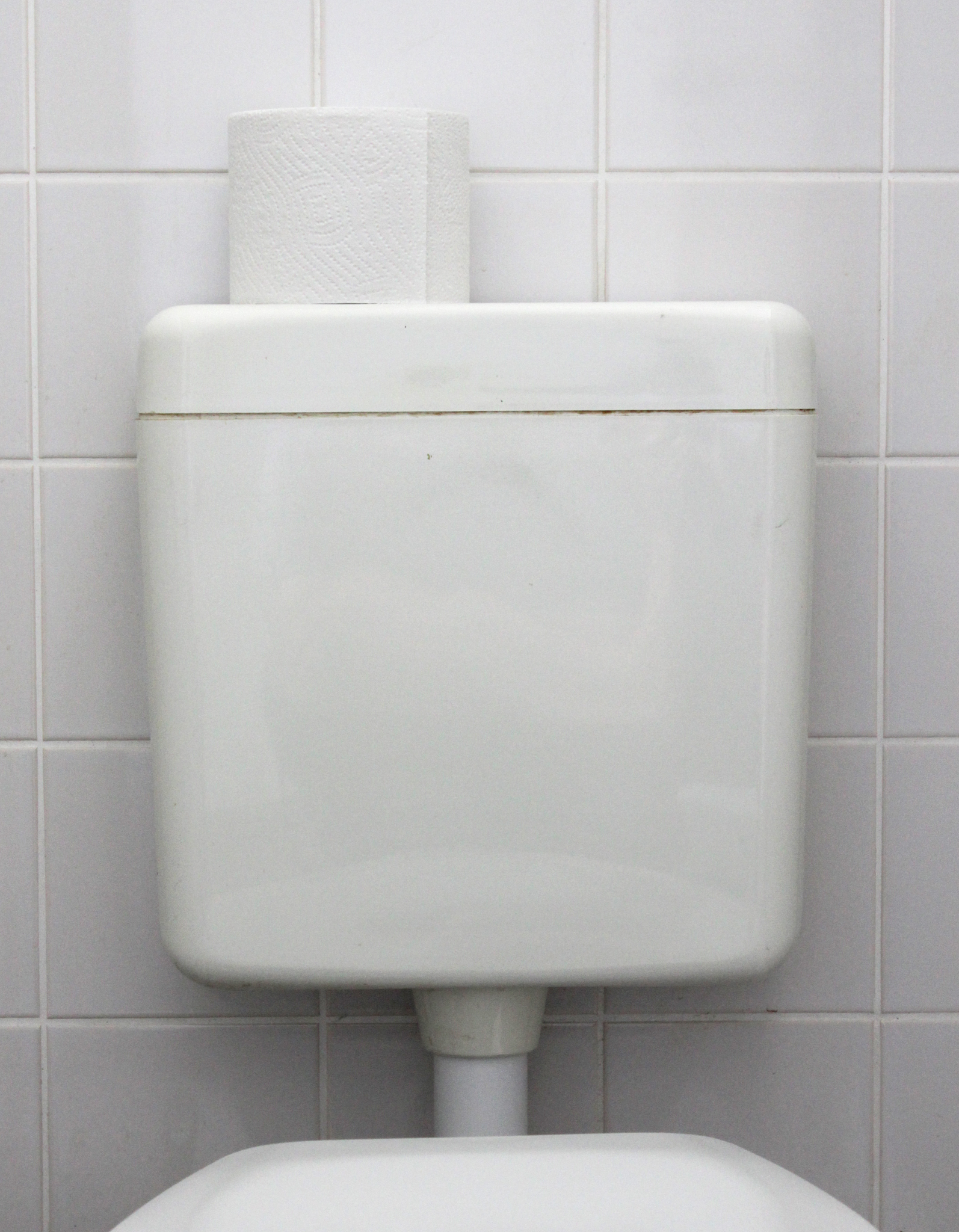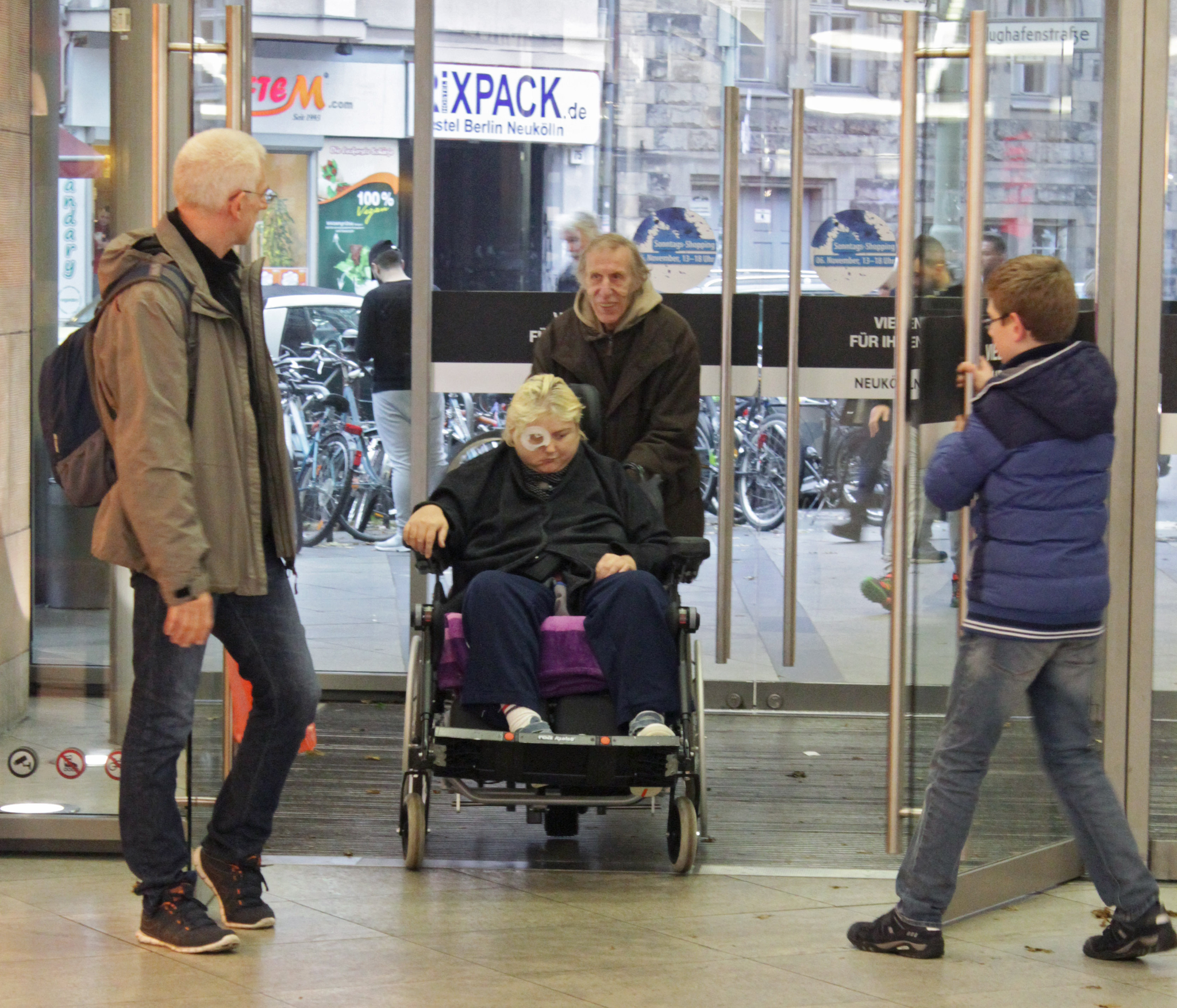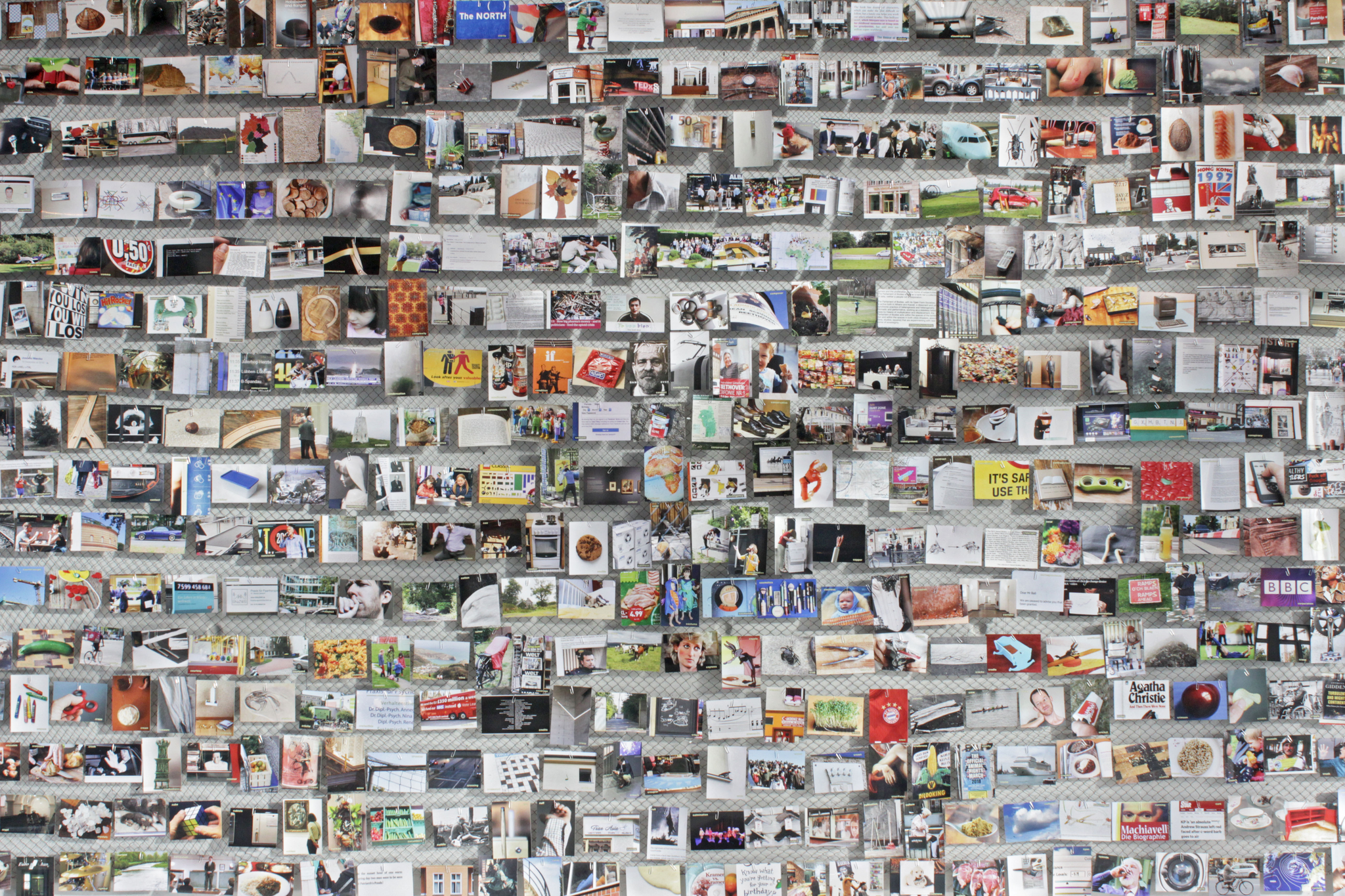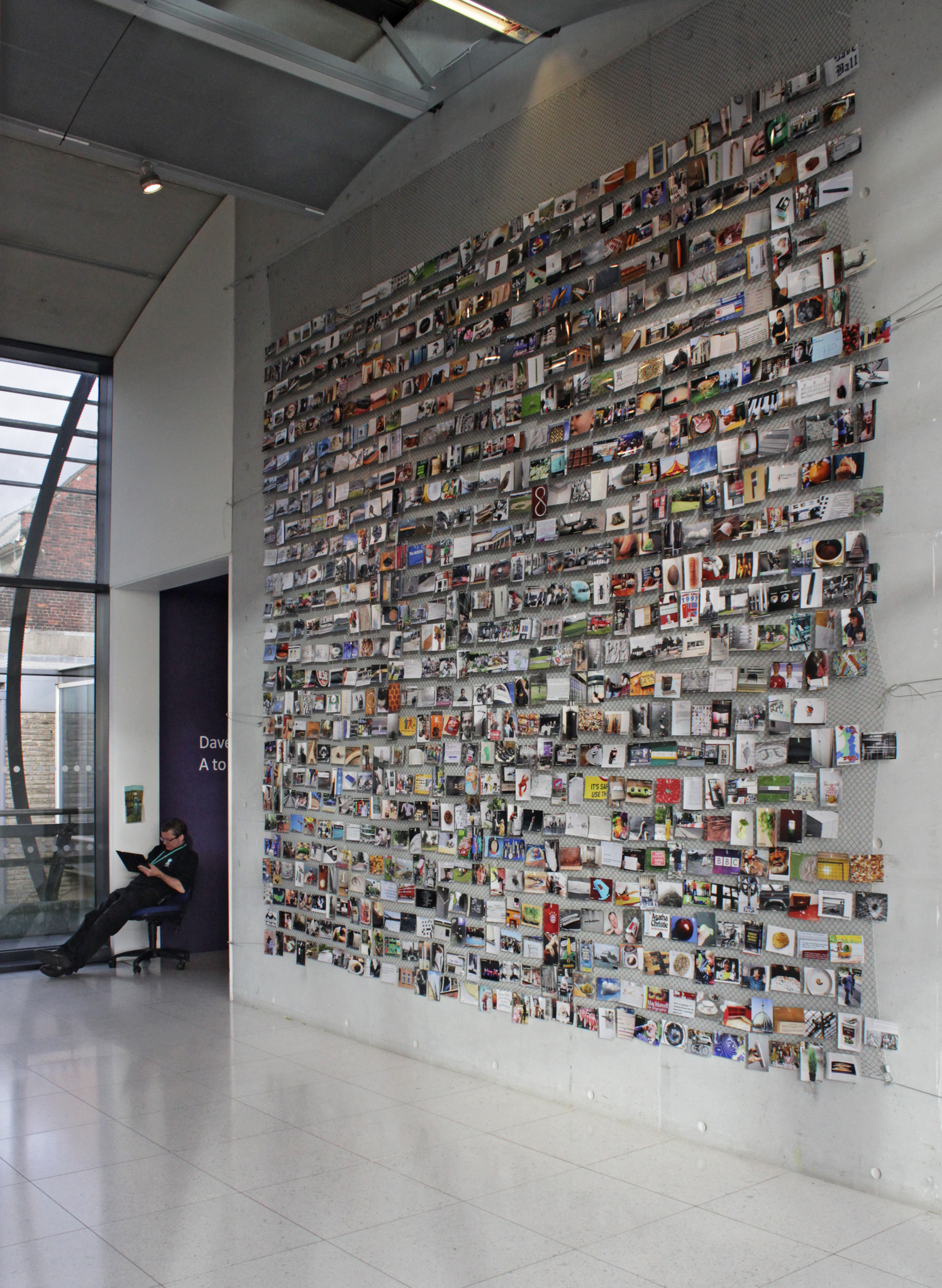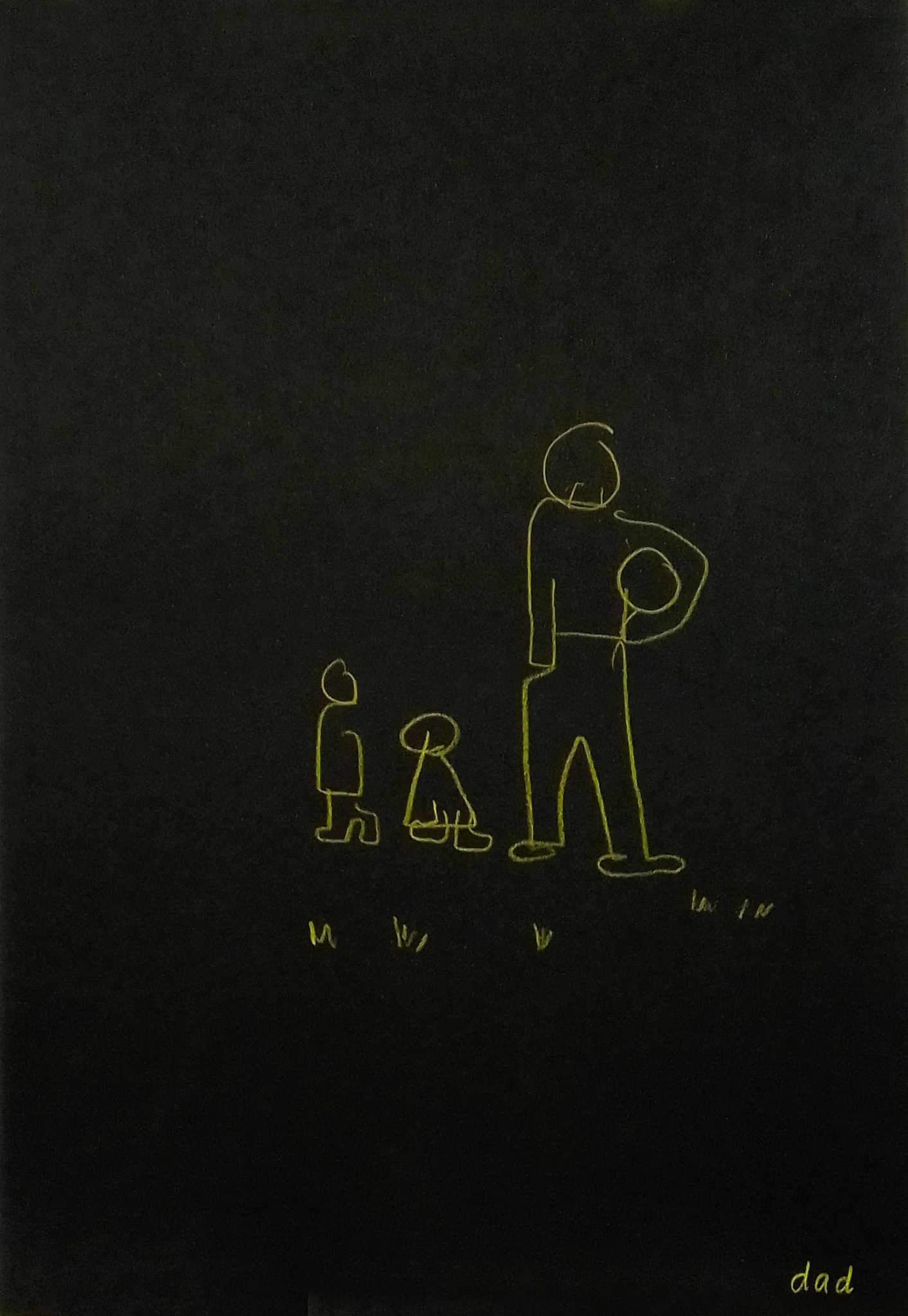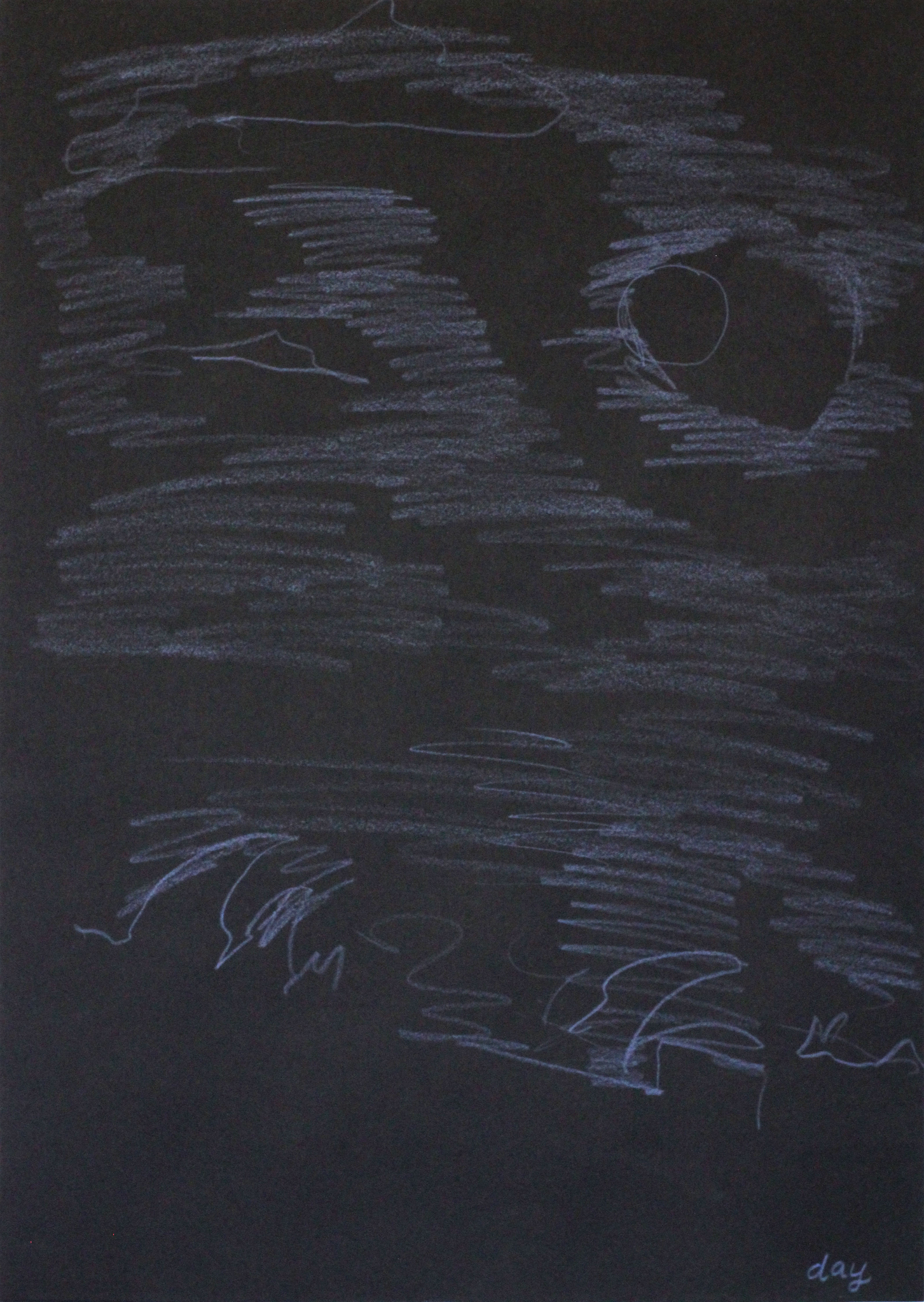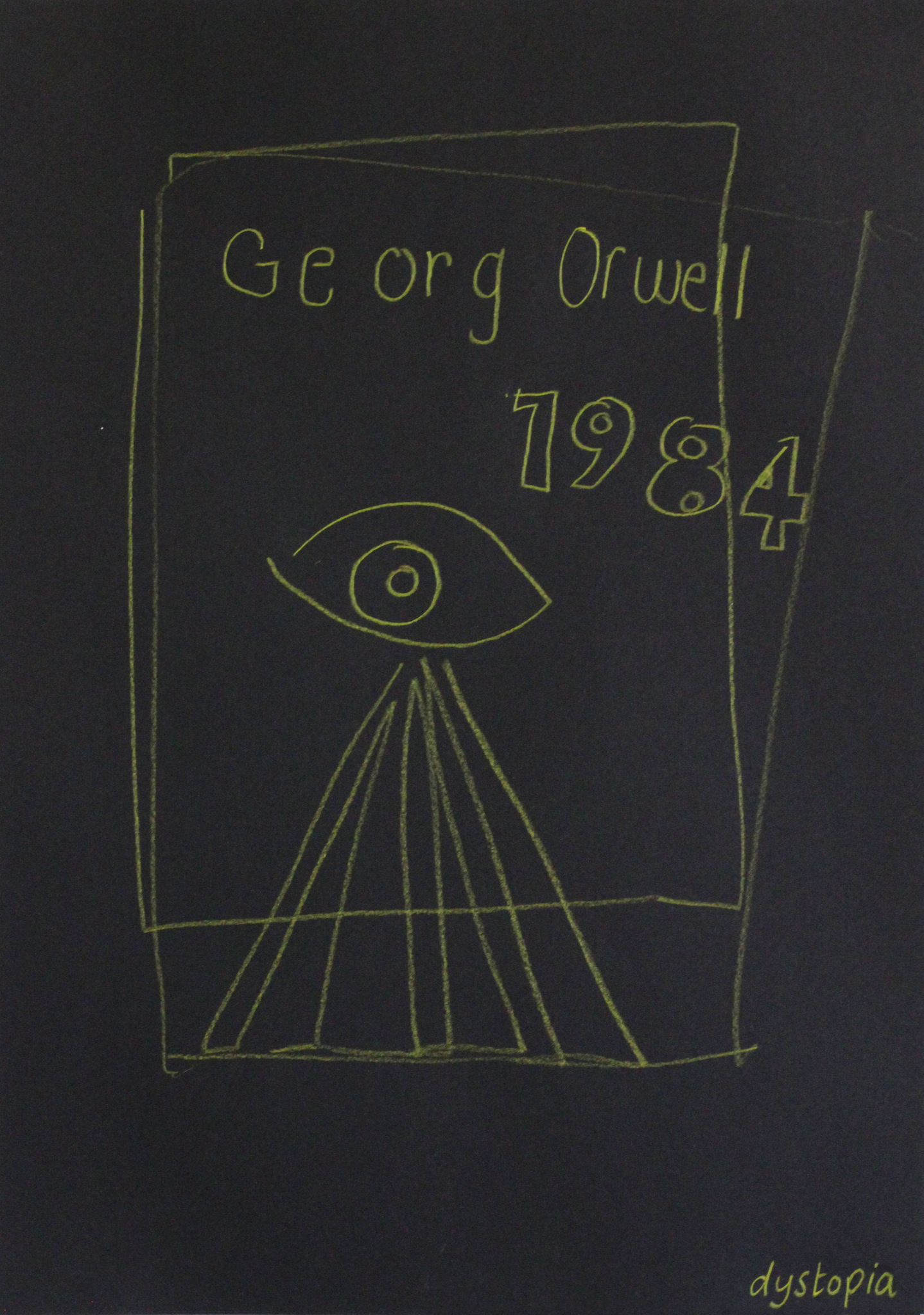{ Prelude }
I can barely even remember what I was thinking about when I drew “abacus”. It was only the second drawing I’d done, one of those words on the first page of the dictionary. I probably liked that it was a real thing, an object, as opposed to an abstract concept like the next word, “abandonment”. It would also have given me an early warning that the project was going to test the limits of my patience and stretch the powers of my curiosity to breaking-point: I had, I would have quite quickly realised, absolutely no interest in abacuses. I wanted only to get the drawing done, and move on to the next one. In fact, I vaguely recall losing interest in the drawing even as I was doing it: staring at those joyless pencil spheres I was perfunctorily sketching out one after another to represent beads on an abacus, I was already beginning to wonder what I’d let myself in for...
Introduction
A to Z is an ongoing project initiated in 2011 that seeks (by some time around 2046) to visualise every word listed in the Concise Oxford English dictionary in alphabetical order. Devised as a series of 26 successive semi-independent projects defined by a particular letter of the alphabet, each iteration introduces some new conceptual parameter or media specification, which must be adhered to in addition to the rules already laid out for the project as a whole. The As, for example, were defined simply as “drawings”, the Bs as “drawings produced without any visual reference material (i.e. entirely from memory)”, the Cs as photographs taken “through the lens of my camera”, and the Ds as “drawings executed ‘blindly’ (i.e. without looking at the paper)”.
In seeking to visualise every word in the dictionary over a period of 35 years, A to Z is a manifestly durational project: its extreme length, which quite deliberately draws attention to itself as a preposterous undertaking, is a calculated part of its design. However, in order to be realisable within a working lifetime, certain limitations have been incorporated into the list of rules that underpin the project. For example, the choice of an abridged dictionary, the Concise Oxford, represents a significant reduction in the number of potential words, as too does the specification that ‘only nouns should be visualised’, or that ‘words outside of the vocabulary of the artist should be discarded’. These, and other, defined selection criteria leave around 10,000 words to be visualised – a number that is large enough to cement the project’s absurd scale, yet small enough that the task of visualising every word might conceivably be achieved by a sufficiently motivated and dedicated individual within their lifetime. The project thus falls somewhere between a fantastical conceit and an entirely plausible, if unusually lengthy, proposal for a piece of endurance art.
After the recent visualisation of the 2,258th word in the dictionary, “dystopia”, the Ds have now been completed. Since the conceptual and media parameters for the Es have yet to be decided, this exposition occupies a temporal hiatus in the A to Z project, offering both an opportunity for a retrospective reflection on the work produced so far, and a chance to speculate on how the project might develop in the future as it continues to evolve. Drawing out various themes operative within the project, the exposition will set out to explore the functionality and value of its adherence to a set of absurdly-conceived conceptual rules. The work is represented here through a chronological selection of its visualisations combined with a written account that, comprised of an alternating series of theoretical reflections and first-person vignettes of life in the studio, adheres to Janneke Wessling’s characterisation of artistic research as a mode of operation in which ‘action and thought are inextricably linked’ (2011: 2). Its methodological approach is autoethnographic in the sense defined by Carolyn Ellis et al. as that which ‘acknowledges and accommodates subjectivity, emotionality, and the researcher’s influence on research’ (2011: 3). In other words, what is presented here is simultaneously an abstracted account of an artistic undertaking that attempts to situate and make sense of it within a certain artistic and cultural tradition, and a concrete reminder that, as its author, I am inescapably bound up with the conditions of its creation, and, moreover, at any given point in its development, am neither convinced by, nor indeed fully understand, its meaning and value.
{ Interlude }
“Adversity”: it was one of those words that didn’t immediately lend itself to visualisation. Somehow it resisted being distilled into a single image. It had, simply, no archetypal visual equivalent. Words like that are like riddles that have to be solved; they require a leap of imagination and a not inconsiderable amount of mental effort. I don’t like them much: they exhaust me, and I wish I could just leave them out like I do with words I don’t know the meaning of, like “abulia”, “actinometer”, “adminicle”, or “adobe”. But I definitely know what adversity means, so that wasn’t an option here. Anyway, sooner or later an idea emerges, triggered by something I’ve seen or read, or by pinning down the very first association that pops into my head. Adversity… adversity… adversity… There were a lot of instances of bad luck in the world; how on earth could a single one of them stand for the general “condition of adverse fortune”, as the dictionary had it? In the end I drew a cartoon of a sheep that had accidentally slipped over the edge of a cliff. I was quite pleased with that one, actually.
(Ir)rationality and rules: The spinning gears of a machine disconnected from reason
In an acknowledgement of its instruction-based conceptual art heritage, the A to Z project, whenever it is exhibited, is accompanied by a list of rules [see Appendix below] that specify how its directive to “visualise every word listed in the Concise Oxford English dictionary in alphabetical order” is to be implemented. Some of those are clarifications of what is implicit in the basic premise (for example, that “one visualisation should be made of each word”), whilst others add detail (the dictionary to be used is the “seventh edition, 1982”). The largest category of rules, however, is concerned with the interpretation of the modifier “every”. Much of this relates to the vexed issue of what exactly constitutes a distinct word, which is brought to the surface whenever the question of “how many words are there in a language?” is posed. Complications arise due to technical distinctions between words and their senses, inflections, classes, or compounds, and the issue is only partially resolved by adhering to dictionaries’ own divisions between “headwords” and “derivatives”. Based on the classificatory conventions of lexicography, the rules in the A to Z project concerning the definition of a “word” (“compound words should be discarded, unless they are written without spaces or hyphens” or “only one sense of words with multiple senses listed under one headword should be chosen”) are, then, far from inevitable.
Indeed, the qualities of objective necessity and reasoned logic often associated with rule-based art are also revealed, on closer inspection, to be somewhat misplaced. An overly literal reading of Sol LeWitt’s declarative statement that ‘the idea becomes a machine that makes the art’ (1967: 214), for example, has historically led to a narrowly rational understanding of the modality of conceptual art that struggles to accommodate its more lyrical impulses, such as that of Gerhard Richter’s systematic photographing of clouds in his Atlas (1962–ongoing). Despite his own insistence that ‘irrational thoughts should be followed absolutely and logically’ (1969: 222), LeWitt’s work has been subject to a certain overlooking of what Rosalind Krauss describes as its ‘mad obstinacy’ (1978: 54). Writing in the late 1970s, Krauss was protesting against what she saw as a misjudged characterisation of conceptual art as a ‘triumphant illustration of the powers of human reason’ (46) that wanted to understand its machinic ideas as ‘axiom[s] by which all the variables of a given system might be accounted for’ (51).
In a work such as Wall Drawing 46 (1970) – one of the artist’s long-running series of wall-drawings designed to be realised by assistants – the sparseness of the textual instruction (“vertical lines, not straight, not touching, covering the wall evenly”) could hardly be described as “axiomatic”. Indeed, when the work is encountered in its realised form, its studiously executed lines spreading out more-or-less vertically and more-or-less evenly across the gallery wall, replete with the imperfections, idiosyncrasies, and expressiveness of the human hand, the interpretative work required for its implementation is plain to see. LeWitt’s initial claim that ‘when an artist uses a conceptual form of art, it means that all the planning and decisions are made beforehand and the execution is a perfunctory affair’ (1967: 213–14), is perhaps better read as an overstated, manifesto-like declaration of a new order than an accurate description of the complexity, play, and, in the words of one critic, ‘absurdist or Sisyphean logic’ of much of the work he and his contemporaries were actually producing (Cocker 2010: 265).
Comically overreaching in its ambition, Douglas Huebler’s Variable Piece #70 (1971–97) is a case in point. Setting out to ‘photographically document ... the existence of everyone alive in order to produce the most authentic and inclusive representation of the human species that may be assembled in that manner’ (quoted in Osborne 2002: 30), Huebler pursued this quixotic task until the end of his life, periodically displaying the results in varying configurations that included photographs of groups of people in public, close-ups of individual faces, and textual descriptions of the precise times and locations of the encounters. The inherent absurdity of the work’s ruling directive (which is always displayed as an integral part of the work) appears to destabilise its own conceptual authority, with the rule and its various outcomes performing what the artist himself described as a kind of “dance” (Kelley 2003: 180).
The deployment of rules in the A to Z project operates within a similar tension, namely, that it is never clear whether its rules exist as future-oriented instructions aimed at the realisation of an idealised concept (LeWitt’s “irrational thought”), or whether they are, in fact, attempts at a retrospective rationalisation of an (irrational) activity. Do the rules tend towards the irrational, or are they attempts at its rationalisation?
In practical terms, the answer is straightforward, since I can of course remember (more or less) the moment at which I drew up the rules: it would have occurred somewhere between the initial spurt of ten or so drawings I made fairly unreflectively at the beginning of the project and the subsequent, slower and more self-conscious advance through the next two or three pages of the dictionary. Specifically, I would have been unsure as to whether or not I ought to visualise a word such as “abetment” (whose meaning I barely knew), and then, having chosen not to draw it, I would have sought some means of making that fairly arbitrary decision hold for the entire project. In theoretical terms, however, the role played by the rules remains something of a conceptual conundrum.
Focussing on one of its historical forebears in an analysis that might equally be applied to the methodical absurdity of A to Z, Krauss observed that ‘once the term was put in play, “conceptual art” was like a ball that the art-world immediately ran with, driving deep into the territory of Idealism … But LeWitt’s “ideas” are not generally to be found in that high place. The kind of idea he inevitably uses is subversive, addressing itself to the purposelessness of purpose, to the spinning gears of a machine disconnected from reason’ (1978: 57). The appeal by the conceptual artist to the authority of rules, then, does not lead to any kind of necessary rationalism or objectivity; rather, it acts as a means of systematising a particular activity – however irrational, arbitrary, or interpretatively open-ended that activity might be.
{ Interlude }
It seemed like it wasn’t enough any more to just draw the words. I’d finished the As in something of a flurry in time for an exhibition – where they went down quite well, all things considered. People liked the drawings: they kept saying I had a real talent for it. Indeed, one drunken artist raged at me after watching some videos I’d screened alongside them: “just stick to drawing!” she said; “that’s what you’re good at!” But I didn’t want the drawings to be objectified like this: I wanted people to think about how and why I was making them, not how “good” they were. So when I started the Bs I banned myself from looking at any visual source material. One of the first words was “baboon”. I’ve never been able to draw animals, and since I couldn’t remember what a baboon looked like anyway, that drawing turned out to be pretty awful in almost every way. This was more like it!
An extended moment of humour?
Structurally speaking, the basic one-line premise of the A to Z project functions rather like a gag. It begins with a concise and pithy setup:
“Here’s what I'm going to do for my next project,” explains a serious-minded and apparently level-headed contemporary visual artist working in a conceptual and critical tradition...
and then, flouting the expectations of what such an artist might ordinarily be expected to do, delivers its punchline:
“I’m going to spend the rest of my life visualising every word in the dictionary in alphabetical order!”
Through its promise to embark on an undertaking of such systematic and apparently foolhardy immensity, in other words, the project is perceived to have violated some sort of contextual norm, thus giving rise to a comic incongruity.
Unlike in a more conventional encounter with humour, however, the realms of the congruous and the incongruous that produce the discrepancy here quickly become rather indistinct. Jokes ordinarily play upon a shared understanding of a given social or linguistic context for their functionality: on hearing the setup to a joke, we draw upon our knowledge and experience of the context it invokes, appealing to schematic “scripts” of behaviour and utterance in order to make sense of what we see and hear (Martin 2007; Miller 1988). The punchline deviates from the anticipated script, unexpectedly eliciting an entirely different one, and thus producing a humorous incongruity. If, however, the listener does not recognise this discrepancy, they will not get the joke. Comedy is, in this sense, a rather all-or-nothing activity; artists, in contrast, who trade in ambiguity, complexity, and open-ended interpretative play, are much less likely to worry if their audiences do not “get” their joke. The realms of humour and the serious, in their case, are more fluid, their borders muddied by their framing as “art”.
Drawing on the work of phenomenological sociologist Alfred Schutz, with his positing of “finite provinces of meaning” to describe the stratification of the world we inhabit and act within, where everyday, common-sense “reality” is encountered as distinct from the realities of, for example, the dream, play, or religious experience (Schutz & Luckmann 1973), Peter L Berger has argued that humour occupies its own “island” within a “paramount reality” (2014). The comic, for Berger, ‘conjures up a separate world, different from the world of ordinary reality, operating by different rules’ (xiv). In ‘ordinary, everyday life,’ he suggests, humour ‘typically appears as an intrusion. It intrudes, very often unexpectedly, into other sectors of reality. These other sectors are colloquially referred to as serious’ (6, original emphasis). As an illustration, we are invited to imagine the sober proceedings of a business meeting suddenly interrupted by a joke, after which the statement, “but now, seriously” signals an end to the humorous intervention, returning the meeting to a realm of pragmatic reality (7). The joke, then, demands a momentary reframing of experience, giving rise to an alternative world that only makes sense on its own terms.
Laughter, indeed, can often be heard when I explain the premise of the A to Z project: there appears to be, on some level, something quite funny about it. Unlike with a comedian’s joke, however, there is no clear boundary separating the “comic” world of this premise and the “pragmatic” world in which the promised activity will actually take place. When the laughter of my listeners (or at least, their look of confusion and disbelief) has subsided, they are still in the same place, left trying to make sense of the fact that, yes, I really am going to visualise every word in the dictionary in alphabetical order, and that yes, it really will take me the rest of my working life to do it.
Berger’s analysis invites comparisons with Mikhail Bakhtin’s theorisation of the carnivalesque as a ‘world “turned inside out”,’ a liberation from ordinary reality in which rules and hierarchies are cast aside (1984: 370). Bakhtin’s famous claims of revolutionary transgressiveness are, however, at least according to Umberto Eco, ‘unfortunately false’ (1984: 3), precisely because carnivals, by their nature, are temporally and spatially limited, and therefore ‘only exist as an authorised transgression’ (6, original emphasis). The ‘moment of carnivalisation must be very short, and allowed only once a year,’ argues Eco; ‘an everlasting carnival does not work: an entire year of ritual observance is needed in order to make the transgression enjoyable’ (ibid.).
Attributing the humour of A to Z to its breaking of rules, then, would appear problematic on two levels. For not only is it difficult to pinpoint what “script” or “contextual norm” its premise actually deviates from (there is certainly no embargo on the use of absurd concepts in contemporary art, even if such approaches sit rather uneasily within the canon (Gérin 2013; Heiser 2008; Higgie 2016), and thus to convincingly model it as a humorous incongruity. But also, and perhaps more significantly, it is the extended temporality of A to Z that ultimately prevents its gag-like premise from being safely contained within some clearly demarcated “island” of humour. The extreme duration of the activity demanded by its underlying premise, that is, far exceeds any conceivable carnivalesque moment.
{ Interlude }
By the time I reached the word “cirrus”, I’d already been doing the Cs for two years. I’d decided for that letter to switch to photography, partly to establish that the project wasn’t only about drawing, but partly also to speed up the process, since I knew there were a lot of C-words in the dictionary. This, I soon realised, was hopelessly naïve, since photographing things involved going out into the world and finding them. Which is why I had to spend days gazing up at the sky waiting for an appropriately thin streak of wispy cloud. Next was “cistern”, which was much more straightforward: my only slight concern being that one of my studio-mates might find me snapping away in the toilet. And then, a few days later, “civility”, which I decided would be best encapsulated by an image of someone politely holding open a door in a public building. After almost half an hour poised near the entrance of my local shopping centre waiting for a display of common decency, I was finally able to photograph – in what proved to be a rare exception to the growling-faced indifference of the Berlin public that afternoon – a father and son ceremoniously holding open a pair of double doors for a wheelchair user. This was hard work, and it would continue relentlessly for four years, knitting together a strange kind of thread through my life – of banality, chance encounter, and (to the obvious delight of my children) repeated trips to the zoo in pursuit of camels, cobras, and chimpanzees.
Tactical absurdity or, breaking rules as a rule
The initial idea for the A to Z project was sparked by my research into chance procedures, and in particular, the use of randomness as a means of fostering creativity. Edward de Bono’s writings on lateral thinking were instructive: one of his techniques for breaking free from the ‘restricting patterns’ of ‘vertical thinking’ involved choosing a random word on a random page of a dictionary and applying that word to whatever problem was at hand (1970: 10–11). Such use of ‘random stimulation,’ was, in de Bono’s view, ‘fundamentally different from vertical thinking. With vertical thinking one deals only with what is relevant … With random stimulation one uses any information whatsoever;’ in fact, ‘the more irrelevant the information the more useful it may be’ (169).
Reaching for the dictionary that happened to be on my shelf at the time, I tried out the technique; whilst the words I chanced upon led to little of practical value, the process itself of selecting a random word and being confronted by its determined irrelevancy was nonetheless compelling. By working through its contents in strict sequential order, the organising principle of the dictionary was turned against itself, its alphabetical logic followed, ad absurdum, to the letter.
Whilst de Bono’s aid to lateral thinking takes advantage of randomness to bypass what he saw as the mind’s unhelpful tendency to process its surroundings according to established structures of relevance, coherence and sense, it does so only temporarily, for whatever insight the randomly-selected word allows, it ultimately serves a sensible end (as de Bono puts it, ‘if an idea is tenable at all then it must be possible in hindsight to see how it could have been arrived at by logical means’ (174, my emphasis)). If, however, the technique is pushed to its limits, where all that is left is the lateral thought itself, then it never serves any goal-oriented and retrospectively “useful” end.
The self-imposed task of visualising the entire dictionary in alphabetical order, then, is as arbitrary as it is absurd. The precise and objective tone of the list of rules specifying how the task is to be carried out merely reinforces the fact that, from a pragmatic point of view, it is an exercise wholly lacking in usefulness. As long as the project is active, however, I am bound to this purposelessness; to fail to uphold any individual stipulation – for example, by skipping sections of the dictionary, by being selective in the words I visualise, or even by ceasing altogether – would be to break with the central unwritten “rule” that says that I must continue to engage with this entirely unnecessary and ludicrous activity. To break with those rules, in other words, would be to cease being absurd.
By adopting what I have come to think of as a “tactically absurd” approach to art-making (Ball 2019; 2020a; 2020b), I am effectively entering into a somewhat contradictory contract that requires me to think simultaneously strategically and nonsensically, rationally and irrationally. The absurdity of the project is, of course, part of its design: it was conceived deliberately, as a tactical overstepping of the bounds of sense. That the undertaking serves no discernible purpose is precisely its point: it is, to coin a phrase, a pointedly pointless exercise.
Which is not to say that it lacks value. For A to Z is, after all, an artistic experiment: the project remains open (I hope!) to being made sense of through the frame of tactically absurd artistic practice. While the notion of “tactical absurdity” is inherently oxymoronic – in that its (absurd) field of operation is situated outside of what can be fully rationalised, yet it demands to be understood as a rationally implemented mode of operation (a tactic) – when it is adopted within a rule-based practice, its contradictoriness can be wielded as a productive force. Exactly what the value of all this (excessive) production is, however, remains difficult to say, even with the benefit of de Bono’s “hindsight”. What can at least be affirmed about its mode of operation is that if a tactically absurd activity does not follow a rule, then it is not tactical; but if it does not break a rule, then it is not absurd. The only “rule” that tactically absurd practice abides by, in other words, is that it must break rules.
{ Interlude }
So there I was, back in the studio, dictionary in hand, perusing the first few pages of the “D” section. What on earth was I going to do next? An exhibition of the entire sequence of As, Bs and Cs had just opened, filling the walls of a gallery, testament to seven years’ efforts at visualising the world. People were starting to ask what I was going to do next, and whether now might be a good time to stop, since “A, B, C” had a nice ring to it, a certain completeness. But this had never been about “finishing”. The end was so far away that it seemed absurd to even think about it. All that mattered was the next word, and the one after that: “dab”, then “dabbler”, “dad”, then “daffodil”. I thought again about the idea I’d once had for drawing the words without looking at them. It seemed to say something about visualisation. I can’t quite remember what it said, but it said something. Didn’t Derrida curate an exhibition about blindness once? Anyway, I got some paper, closed my eyes and tried to draw a painter making a “dab” on a canvas. It was a bit disjointed, but it worked. And then I drew someone at a desk, getting up, playing a guitar, then returning to their work (a “dabbler”). By the time I got to “dagger” I didn’t care any more if the drawings’ lines didn’t join up, if they went off the edge of the paper, or if they were just incomprehensible marks on a page. It didn’t seem to matter; I quite liked them, and, more to the point, I’d just churned out twenty in an afternoon. The wheels of the project were turning again, and I’d stopped – at least for now – trying to make sense of where it was going.
An(other) ending
Trapped, by virtue of a kind of ethical commitment to conceptual art practice, into following the rules of the project, I have no choice but to continue. Moving from letter to letter – from A to B, from B to C, from C to D, and now, after eleven years, from D to E – these little landmarks allow me to punctuate the unending stream of words, and the endless work of turning them into visualisations. The last word, “dystopia”, was the 487th word beginning with D, and the 487th word I had drawn with my eyes closed. It was no more or less significant than any of the other ones that preceded it; the process was the same: thinking about what associations come to mind, trying to imagine them pictorially, searching online for concrete examples, deciding upon a final visual solution, closing my eyes, attempting to draw what was in my mind, opening my eyes – and being either delighted, disappointed, or indifferent about the result. Except that this was the last word, and it marked the end of the fourth instalment of the A to Z project.
It really should have been something to celebrate. I had got into the habit, part-way through the Ds, of posting the drawings on Instagram; this had partly been to try to sustain my own waning interest in the project. The Ds had begun with great excitement: the process was fun, and some of the drawings that emerged seemed more interesting and more vibrant than anything I could have done with my eyes open. Others were so bad they became compelling in a completely different way. The relentlessness of the task of producing a drawing for every one of the D-words in the dictionary had, however, become increasingly arduous, and more than once I had lost momentum altogether and stopped working for several months. If getting a few likes on social media could prolong my enthusiasm, I had reasoned, then surely that was a good thing. So when I finally drew the word “dystopia” (a reasonably successful rendering of the cover of an old Penguin edition of George Orwell’s novel 1984), it seemed appropriate to post the drawing on Instagram. The post got a grand total of eight likes. Even by my own low standards of social media engagement, this was an underwhelming show of appreciation; aside from a select few friends, well-wishers, and my ever-eager gallerist, nobody seemed to care much at all about this particular landmark. Racked with self-doubt and the nagging feeling that I was wasting my life trying to complete a project based on a flimsy joke that had long ago run its course, this all-too-public commemoration of yet another milestone in development of the project – a conspicuous moment of punctuation marking the transition between one successfully implemented phase of the project’s master plan and the next – seemed ill-fitting, inopportune, and inauthentic.
Such doubts and uncertainties, however, may well be a necessary fallout of the act of creation. Artists are continually called upon to speak with authority about their work – and this very often means adopting the stance of someone who knew, and was confident about, what they were trying to do at the time they were doing it. It is in this spirit of a somewhat artificial distance and a somewhat disingenuous authority that this exposition – which is both an artist’s account of the production of a work and an academic’s analysis of its implications – taking advantage of the “hiatus” offered by the pause between the Ds and the Es, attempts to draw some tentative conclusions about the A to Z project as a rule-based undertaking. The various “interludes” included here thus serve as an important counterpoint: a reminder of Donald Barthelme’s verdict that the knowledge yielded in the creative process only ‘comes into being at the instant it’s inscribed’ (1997: 12). From the point of view of the artist, in the moment of the creation of the visualisations that make up the A to Z project there is no authoritative or stable “meaning” behind the activity – only doubt, confusion and play (manifested, at various times, as boredom, struggle, surprise, satisfaction, exhaustion, frustration, annoyance, and pleasure).
From an academic artist-researcher’s perspective, too, the project of making sense of the activity is no less fraught with difficulty. The project remains stubbornly resistant to any definitive attribution of meaning or value: writing about it feels no less a creative act than making it. Its arbitrariness, its paradoxicality, its refusal to fully submit to any humorous, artistic, or conceptual frame – and above all its absurdity – render it interminably elusive as an object of analysis. It is precisely this difficulty in expounding upon the project that makes writing about it such a compelling task.
Finally, A to Z always comes back to the present moment, in which the only questions that need to be posed are: What is the next word? and How is it going to be visualised? It is the process of doing those endless visualisations that sustains the project, and perpetually defers the question of what any of it actually means, what it is trying to achieve, and what value it might hold. In this sense, the project can only be reconstructed retrospectively, by looking back at what has been produced and imagining that the nonsensical premise that underpinned it somehow made sense from the beginning.
{ Coda }
I’m sitting here in my studio thinking about the grant I've just received. It was a surprise when I got the news: it seems like a long time since anyone has given me any money to make art. And, to be honest, I’d completely forgotten what it was that I applied for the money for. When I went back and looked at my proposal, and remembered that I’d applied to do the E-words of A to Z as a long series of improvised actions documented on video, my heart sank. Oh, I thought, it was THAT project. And oh, it was THAT idea. The first word in the E-section of the dictionary is “eagle”. Which means that I (or preferably somebody else slightly better suited to physical theatre I can convince to collaborate with me) will have to somehow enact this particular bird of prey as a short performance in front of a camera. And then I (or they) will have to do the same thing for the next word, and the next one, and the one after that, and so on until I (or they) have done more than 300 short performances. This is what awaits: this is what I’m going to have to do next. I feel a bit sick at the thought of it. But, hey-ho, rules are rules, and the particular rule I made for myself is the one that says I’ve got to visualise the entire dictionary in alphabetical order, so I guess that’s the rule I’ll to have to stick by...
References
Bakhtin, Mikhail (1984[1965]) Rabelais and His World [trans. from Russian by Helene Iswolsky]. Bloomington, IN: Indiana University Press.
Ball, Dave (2019) ‘Searching for the Perfect Welsh Mountain: A Performance of Tactical Absurdity,’ Performance Research, vol. 24, no. 2, ‘On Mountains,’ pp.24–31.
Ball, Dave (2020a) ‘Doing Things Alphabetically: Sartre’s Autodidact and Tactically Absurd Practice,’ Writing Visual Culture, vol. 9, ‘Artists and the Philosophers We Love,’ pp.17–27.
Ball, Dave (2020b) ‘The Use of Tactical Absurdity in (Post-)Conceptual Art Practice.’ PhD thesis, University of Southampton.
Barthelme, Donald (1997) ‘Not Knowing,’ in Donald Barthelme & Kim Herzinger (ed.), Not Knowing: The Essays and Interviews of Donald Barthelme. New York: Random House, pp.11–24.
Berger, Peter L (2014) Redeeming Laughter: The Comic Dimension of Human Experience [2nd edition]. Berlin & Boston: Walter de Gruyter.
Cocker, Emma (2010) ‘Over and Over, Again and Again,’ in Isabelle Loring Wallace & Jennie Hirsh (eds.), Contemporary Art and Classical Myth. Surrey: Ashgate Publishing, pp.265–92.
de Bono, Edward (1970) Lateral Thinking: A Textbook of Creativity. London: Penguin Books.
Eco, Umberto (1984) ‘The Frames of Comic “Freedom”,’ in Thomas A Sebeok (ed.), Carnival!. Berlin, New York & Amsterdam: Mouton Publishers, pp.1-9.
Ellis, Carolyn, Tony E Adams & Arthur P Bochner (2011) ‘Autoethnography: An Overview,’ Forum: Qualitative Social Research, vol. 12, no. 1 [accessed 3/10/2022 at http://www.qualitative- research.net/index.php/fqs/article/view/1589/3095].
Gérin, Annie (2013) ‘A Second Look at Laughter: Humor in the Visual Arts,’ Humor: International Journal of Humor Research, vol. 26, issue 1, pp.155–76.
Heiser, Jörg (2008) All of a Sudden: Things That Matter in Contemporary Art. Berlin & New York: Sternberg Press.
Higgie, Jennifer (2016) ‘These Foolish Things: Dada’s Centenary and the Importance of Absurdity,’ Frieze, no. 177, Mar, p.17.
Kelley, Mike (2003) ‘Shall We Kill Daddy? (On Douglas Huebler),’ in Mike Kelley & John C Welchman (ed.), Foul Perfection: Essays and Criticism. Cambridge, MA & London: MIT Press.
Krauss, Rosalind (1978) ‘LeWitt in Progress,’ October, vol. 6, Autumn, pp.46–60.
LeWitt, Sol (1967) ‘Paragraphs on Conceptual Art,’ Artforum, vol. 5, no. 10, Summer. Reprinted in Peter Osborne (ed.) (2002) Conceptual Art: Themes and Movements. London & New York: Phaidon Press, pp.213–15.
LeWitt, Sol (1969) ‘Sentences on Conceptual Art,’ Art-Language: The Journal of Conceptual Art, vol. 1, no. 1, May. Reprinted in Peter Osborne (ed.) (2002) Conceptual Art: Themes and Movements. London & New York: Phaidon Press, p.222.
Martin, Rod A (2007) The Psychology of Humour: An Integrative Approach. Burlington, MA, San Diego, CA & London: Elsevier Academic Press.
Miller, Jonathan (1988) ‘Jokes and Joking: A Serious Laughing Matter,’ in John Durant & Jonathan Miller (eds.), Laughing Matters: A Serious Look at Humour. Harlow, Essex: Longman, pp.5–16.
Osborne, Peter (2002) ‘Survey,’ in Peter Osborne (ed.), Conceptual Art. London & New York: Phaidon Press, pp.12–51.
Schutz, Alfred & Thomas Luckmann (1973) The Structures of the Life-World, Vol. 1 [trans. from German by Richard M Zaner & H Tristram Engelhardt Jr]. Evanston, IL: Northwestern University Press.
Wesseling, Janneke (2011) ‘Introduction,’ in Janneke Wesseling (ed.), See It Again Say It Again: The Artist as Researcher. Amsterdam: Valiz, pp.1–16.
A to Z: Rules
1. Words should be visualised in alphabetical order, starting at “a”.
2. One visualisation should be made of each word.
3. Every word listed in the Concise Oxford English Dictionary (7th edition, 1982) should be visualised, with the following restrictions:
(i) Unfamiliar words (i.e. words outside of the vocabulary of the artist) should be discarded.
(ii) Only nouns should be visualised.
(iii) Proper nouns should be discarded, unless they are listed without capitalisation (e.g. “aboriginal” should be visualised, but not “Apollo”).
(iv) Obscure, technical, specialist, or scientific words should be discarded (unless they are in general usage).
(v) Only one visualisation should be made per word listed (i.e. per headword). Only one sense of words with multiple senses should therefore be chosen (e.g. “boot” should be visualised either as “a tough leather shoe”, or as “the luggage compartment of a car”).
(vi) Only one of a group of closely-related derivatives listed as separate headwords (e.g. “critic”, “criticality”, “criticism”) should be visualised. Orthographically similar words whose meanings are distinct (e.g. “affect”, “affectation”, “affection”) should, however, be visualised separately.
(vii) Compound words should be discarded, unless they are written without spaces or hyphens (e.g. “courtyard” should be visualised, but not “court martial” or “court-house”).
(viii) Synonyms should be treated as separate words (e.g. “achievement” and “accomplishment” should both be visualised).
(ix) Only one visualisation should be made of words listed separately under alternative spellings (e.g. “cipher” and “cypher”).
(x) Foreign words which have not been naturalised into English (i.e. those with headwords in italics) should be discarded (e.g. “aperitif” should be visualised, but not “aficionado”).
4. Except where specified for a given letter, there is no restriction on approach, style, size, media, or interpretation.



